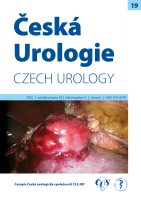

127
Ces Urol 2015; 19(2): 118–130
PŘEHLEDOVÝ ČLÁNEK
Studená ischemie (cold ischemia – CI) má jas-
né výhody v ochraně ledvin při dlouhém ische-
mickém období, ale měla by být použita pouze
v případě, kdy je to zcela nutné. Pokud se očekává
ischemický čas delší než 30 minut, mělo by se CI
použít předem. K možným druhům chlazení při
resekčních výkonech patří metoda in situ stude-
né arteriální perfuze, povrchové chlazení ledovou
tříští, retrográdní perfuze dutého systému nebo
ex situ studená arteriální perfuze s autotransplan-
tací. Technika metod CI závisí na předoperačním
hodnocení, chirurgické technice (otevřená, lapa-
roskopická nebo robotická operace) a zvyklostech
pracoviště. CI může být dle závislosti na způsobu
chlazení tolerována až do doby dvou hodin (u ex
situ arteriální perfuze s autotransplantací). Stále
však platí, že doba CI by měla být co nejkratší,
u nejvíce rozšířené techniky chlazení pomocí le-
dové tříště je doporučována dle literárních údajů
bezpečná doba CI v rozmezí do 35–44 minut.
LITERATURA
1. Novick AC.
Renal hypothermia: in vivo and ex vivo. Urol Clin North Am 1983; 10: 637–644.
2. Marberger M.
Renal ischemia: not a problem in laparoscopic partial nephrectomy? BJU Int 2007; 99: 3–4.
3. Šváb J.
Resekce ledvin, Státní zdravotnické nakladatelství, 1961.
4. Nishikido M, Noguchi M, Koga S, et al.
Kidney transplantation from non-heart-beating donors: analysis
of organ procurement and outcome. Transplant Proc 2004; 36: 1888–1890.
5. McDougal WS.
Renal perfusion/reperfusion injuries. J Urol 1988; 140: 1325–1330.
6. Secin FP.
Importance and limits of ischemia in renal partial surgery: experimental and clinical research.
Adv Urol 2008: 102461.
7. Abuelo JG.
Normotensive ischemic acute renal failure. The New England Journal of Medicine 2007; 357,
8: 797–805.
8. Donnahoo KK, MeldrumDR, Shenkar R, et al.
Early renal ischemia, with or without reperfusion, activates
NFκB and increases TNF- α bioactivity in the kidney, J Urol 2000; 163, 4: 1328–1332.
9. Donnahoo KK, Shames BD, Harken AH, Meldrum DR.
Review article: the role of tumor necrosis factor
in renal ischemia-reperfusion injury, J Urol 1999; 162, 1: 196–203.
10. Thadhani R, Pascual M, Bonventre JV.
Acute renal failure, N Engl J Med 1996; 334, 22: 1448–1460.
11. Newaz MA, Oyekan AO.
Vascular responses to endothelin-1, angiotensin-II, and U46619 in glycerolin-
duced acute renal failure, Journal of Cardiovascular Pharmacology 2001; 38, 4: 569–577.
12. Kourembanas S, McQuillan LP, Leung GK, Faller DV.
Nitric oxide regulates the expression of vaso-
constrictors and growth factors by vascular endothelium under both normoxia and hypoxia. Journal of
Clinical Investigation 1993; 92, 1: 99–104.
13. Lin A, Sekhon C, Sekhon B, et al.
Attenuation of ischemia-reperfusion injury in a canine model of
autologous renal transplantation. Transplantation 2004; 78, 5: 654–659.
14. Hernandez A, Light JA, Barhyte DY, Mabudian M, Gage F.
Ablating the ischemia-reperfusion injury
in nonheart-beating donor kidneys, Transplantation 1999; 67, 2: 200–206.
15. Chiu C, Sievert KD, Dahms S, Bretan P.
Intraoperative reperfusion blood flow predicts post warm
ischemic kidney transplant survival and efficacy of perservation maneuvers. Transplantation Proceedings
1999; 31, 1–2: 1049–1050.
16. O’Hara JF, Hsu THS, Sprung JJB, et al.
The effect of dopamine on renal function in solitary partial
nephrectomy surgery. Journal of Urology 2002; 167, 1: 24–28.
17. Gilbert TB, Hasnain JU, FlinnWR, et al.
Fenoldopam infusion associated with preserving renal function
after aortic cross-clamping for aneurysm repair. Journal of Cardiovascular Pharmacology and Therapeutics
2001; 6, 1: 31–36.



















